How to Raise Happy and Healthy Chickens in Your Backyard
- February 5, 2024
- 0 comment
As a backyard chicken keeper for several years, I’ve navigated the ups and downs of raising poultry in a suburban setting. My journey into chicken keeping began with a simple desire to produce my own eggs and evolved into a rewarding hobby that taught me a great deal about sustainability, animal welfare, and the joys of connecting with nature.
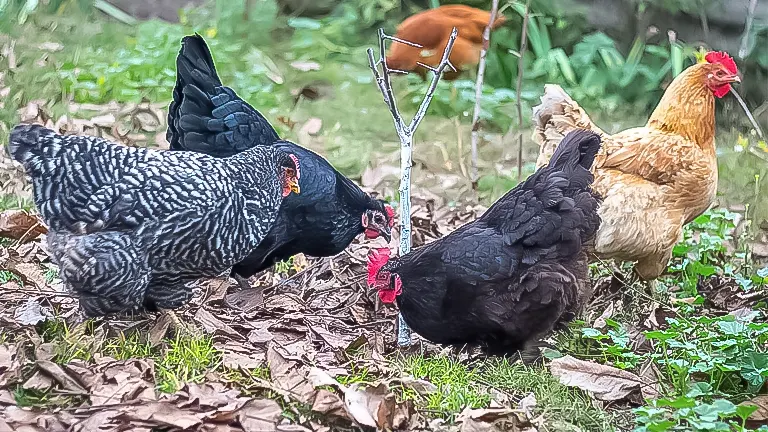
Through trial and error, extensive research, and countless interactions with my feathered friends, I’ve garnered insights and practical tips for anyone looking to embark on this fulfilling endeavor. Here’s my comprehensive guide to raising happy and healthy chickens in your backyard, grounded in personal experience and backed by careful research.
List of How to Raise Happy and Healthy Chickens in Your Backyard:
- Enforce Biosecurity Measures to Prevent Disease
- Keep the Coop Clean and Ensure It Remains Dry
- Maintain Constant Fresh Water Availability with Poultry Nipple Drinkers
- Maintain Constant Fresh Water Availability with Poultry Nipple Drinkers
- Select Age-Appropriate Feed for your Flock’s Nutritional Requirements
- Address and Manage the Behavior of Hens That Become Broody
- Inspect the Chicken’s Droppings on a Daily Basis
- Create a Dust Bath Area for Feather and Skin Upkeep
- Make Sure the Coop is Well-Ventilated
- Fortify the Coop and Run for Predator and Escape Prevention
- Observe Your Chickens Regularly for Signs of Stress
Understanding the Basics for Your Chicken’s Health
Understanding the intricacies of providing a safe and comfortable environment for chickens is the cornerstone of successful backyard poultry farming. The journey begins with constructing a robust coop that serves as a sanctuary against predators such as foxes, raccoons, and hawks, as well as protection from extreme weather conditions be it the scorching sun, relentless rain, or biting cold.
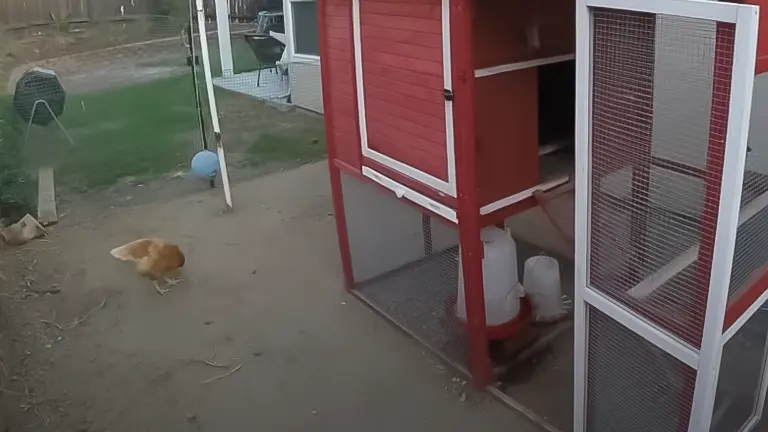
The dimensions of the coop are pivotal, adhering to the guideline of 3-4 square feet per chicken within the coop ensures each bird has sufficient space to roost comfortably without feeling cramped. This space allocation is not arbitrary; it’s designed to foster a stress-free environment that mitigates aggressive behaviors, such as pecking, which can escalate in crowded conditions.
Extending beyond the confines of the coop, the outdoor run, which I recommend sizing at 8-10 square feet per bird, offers a vital arena for chickens to engage in natural behaviors like foraging, dust bathing, and stretching their wings. This balance between indoor and outdoor space not only enhances the physical well-being of the chickens but also plays a critical role in their psychological health, laying the foundation for a harmonious and productive backyard flock.
Step-By-Step for Raising Happy and Healthy Backyard Chickens
Step 1: Enforce Biosecurity Measures to Prevent Disease
Implementing strict biosecurity measures is crucial for keeping your flock healthy and preventing the spread of disease. This involves a comprehensive approach that includes regularly disinfecting the coop and equipment, controlling access to your birds by limiting visitor contact, and implementing quarantine procedures for new or sick birds to prevent the introduction and spread of infections.

Regularly washing your hands before and after handling your chickens, changing into dedicated barn shoes and clothing before entering the coop area, and preventing wild birds or rodents from accessing feed and water supplies are all part of a robust biosecurity plan.
These preventive strategies are vital for maintaining a healthy flock and ensuring the longevity and productivity of your chickens.
Step 2: Keep the Coop Clean and Ensure It Remains Dry
A clean and dry coop is fundamental for preventing disease and keeping your chickens happy and healthy. Moisture is a breeding ground for bacteria and parasites, which can lead to health issues like respiratory problems and foot rot.
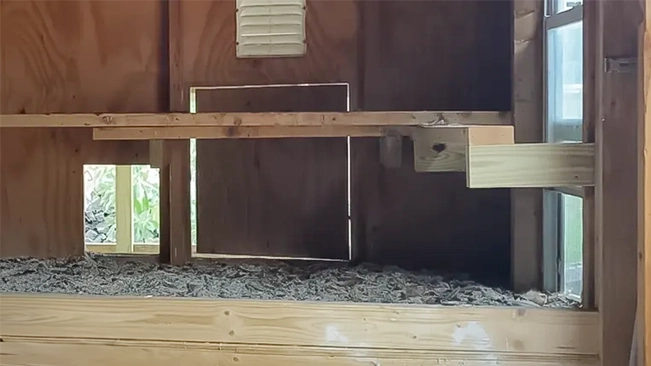
Regular cleaning involves removing manure, soiled bedding, and uneaten food, which can attract pests and promote disease. Replacing bedding with fresh, dry material not only helps absorb moisture but also provides insulation during colder months.
Ensuring proper drainage around the coop and run can prevent water from pooling and contributing to damp conditions. Adequate ventilation is also crucial for removing moisture and ammonia gases, further promoting a dry and healthy living environment for your chickens.
Step 3: Maintain Constant Fresh Water Availability with Poultry Nipple Drinkers
Constant access to clean, fresh water is essential for the health and productivity of your flock. Nipple drinkers for poultry are an efficient and hygienic way to provide water to your chickens. These systems minimize contamination from dirt, bedding, and droppings, ensuring the water supply remains clean and reducing the risk of waterborne diseases.

Nipple drinkers also help conserve water, as they release water only when activated by the chickens, and reduce spillage, keeping the coop drier. Installing a system with enough nipple points to prevent crowding and ensure all birds can drink without stress is crucial for their well-being and encourages optimal hydration, which is vital for egg production and overall health.
Step 4: Select Age-Appropriate Feed for your Flock’s Nutritional Requirements
Feeding your chickens a diet tailored to their specific life stage is key to their development, health, and productivity. Starter feeds are rich in protein to support rapid growth and development in chicks, while layer feeds are formulated with increased calcium levels to support eggshell formation in laying hens.
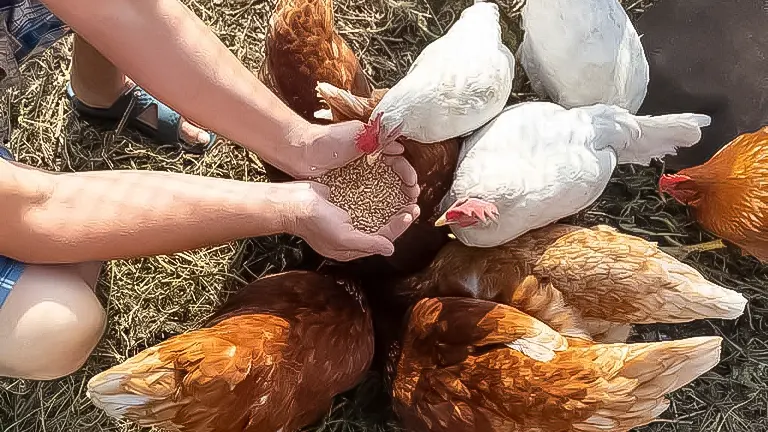
For meat breeds, broiler feeds are designed to promote muscle development and growth. Supplementing with grains, greens, and protein sources like mealworms can provide variety and additional nutrients, but the core diet should always be a commercially prepared feed that meets their nutritional requirements.
Regularly evaluating the health and production of your flock can help you adjust their diet as needed to ensure they are getting the right balance of nutrients.
Step 5: Address and Manage the Behavior of Hens That Become Broody
Broodiness is a natural behavior in hens, where they want to sit on eggs to hatch them, even if the eggs are not fertilized. While this can be beneficial if you’re looking to expand your flock naturally, it can reduce egg production and sometimes lead to aggressive behavior.
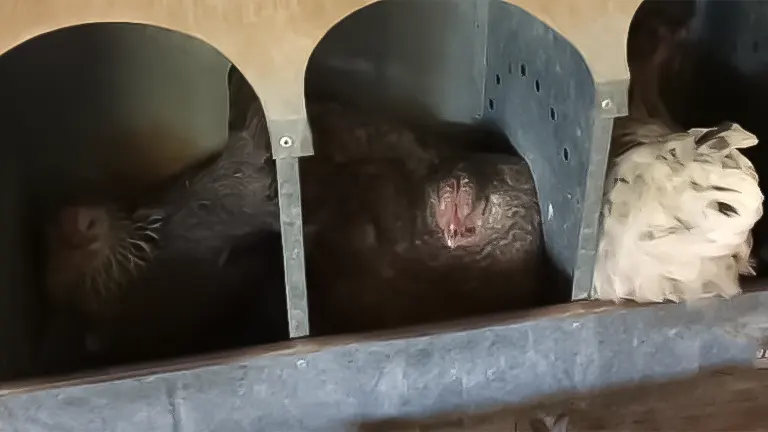
Managing broody hens involves regularly removing them from the nest boxes, collecting eggs frequently to reduce the temptation, and providing a separate area where the broody hen can be isolated from the rest of the flock without nest materials, encouraging her to return to normal behavior.
In some cases, providing a “broody breaker” coop a cage with a wire bottom elevated off the ground—can help discourage broodiness by cooling the underside. Understanding and managing broody behavior is important for maintaining egg production and the harmony of the flock.
Step 6: Inspect the Chicken’s Droppings on a Daily Basis
Regular inspection of your chickens’ droppings is an invaluable practice in monitoring the health of your flock. The condition, color, and consistency of the droppings can provide early indicators of health issues, ranging from dietary imbalances to infections and parasitic infestations.
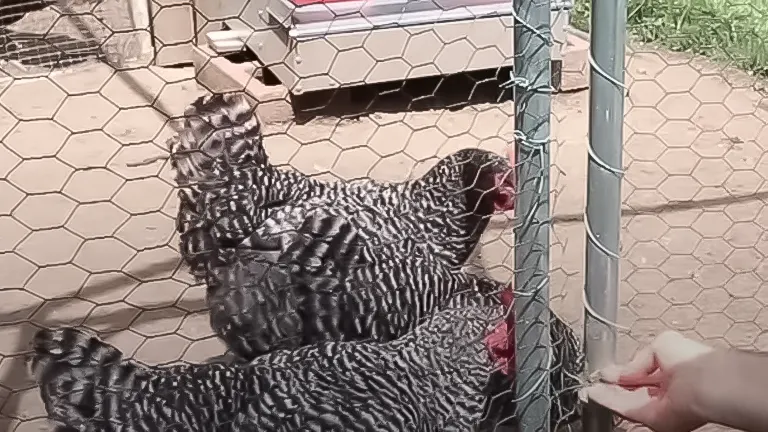
Normal chicken droppings can vary widely, but any drastic changes in color (such as blood presence), consistency (too watery or too hard), or the presence of undigested food can signal potential problems that may require attention or veterinary care.
Implementing a routine for daily checks will help you quickly identify and address issues before they become serious, ensuring the well-being of your chickens and the continuity of egg production. Keeping a reference chart of chicken droppings can be a helpful tool in identifying what is normal and what might be cause for concern.
Step 7: Create a Dust Bath Area for Feather and Skin Upkeep
Dust baths are an essential aspect of chicken behavior, serving as a natural method for them to maintain their feather and skin health. Providing a designated dust bath area filled with a mixture of sand, ash, and diatomaceous earth can help chickens rid themselves of parasites like mites and lice and is crucial for their overall well-being.

This area should be easily accessible, large enough for multiple chickens to use simultaneously, and protected from the elements to keep it dry. Observing chickens enjoy their dust baths is not only entertaining but also reassuring, as it indicates they are engaging in healthy, natural behavior.
Regular maintenance of the dust bath area, such as replenishing the mixture and ensuring it remains dry and free from feces, will encourage its use and contribute to the flock’s health.
Step 8: Make Sure the Coop is Well-Ventilated
Proper ventilation in the chicken coop is critical for removing moisture, ammonia, and carbon dioxide and for supplying fresh air, which is vital for the chickens’ respiratory health and overall well-being. Poor ventilation can lead to a buildup of harmful gases and promote the growth of mold and pathogens, which can result in respiratory issues and other health problems for your flock.

Ventilation should be designed to provide a steady flow of air without causing drafts, particularly in colder weather, to prevent chilling the chickens. Options like vents, windows, or doors that can be opened or adjusted according to the weather conditions can ensure that fresh air circulates effectively throughout the coop while keeping the interior comfortable and safe for the chickens.
Step 9: Fortify the Coop and Run for Predator and Escape Prevention
Securing the chicken coop and outdoor run is essential to protect your flock from predators and to prevent escapes. This involves constructing a sturdy, predator-proof coop and run with materials that cannot be easily torn apart or dug under by predators such as raccoons, foxes, and hawks.

Using hardware cloth instead of chicken wire (which can be easily breached by certain predators), burying it at least 12 inches into the ground around the perimeter, and securing all doors and openings with locks or latches are effective strategies.
Additionally, consider covering the run with netting or wire to protect against aerial predators. Regular inspections for signs of attempted entry or weak spots in the coop and run’s defenses will help you make timely repairs and adjustments, ensuring the safety and security of your chickens.
Step 10: Observe Your Chickens Regularly for Signs of Stress
Regular observation of your chickens is key to identifying signs of stress or discomfort early on. Stress in chickens can manifest in various ways, including reduced egg production, changes in eating or drinking habits, aggressive behavior, feather picking, or unusual vocalizations.
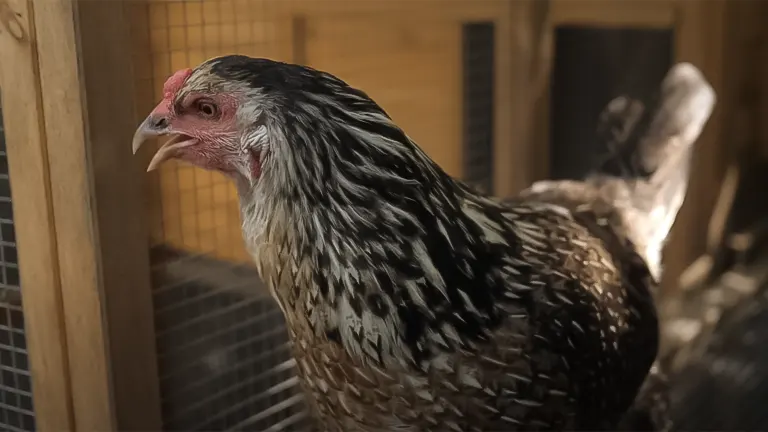
Factors contributing to stress can range from environmental conditions, such as extreme temperatures or overcrowding, to health issues or changes in the flock dynamic. By spending time with your chickens daily, you become attuned to their normal behaviors and can quickly detect any deviations that may indicate stress or illness.
Prompt identification and resolution of these issues are crucial for maintaining the health and productivity of your flock.
Making the Decision
Deciding to raise chickens in your backyard should not be taken lightly. It requires time, investment, and a commitment to their well-being. However, for those willing to take on the responsibility, the rewards are immense. Not only do you get fresh eggs, but you also gain the satisfaction of knowing you’re providing a healthy, happy life for your chickens.
In my experience, the key factors in decision-making have been space availability, time commitment, and local regulations. If you have the space, can commit the time, and are allowed by local laws to keep chickens, I highly recommend this fulfilling endeavor.
Related Articles:
- Best Bedding For Chickens
- Best Safe Chicken Coop Heater
- 8×8 Chicken Coop Plans
- Turning a Shed Into a Chicken Coop
- How to Make a Chicken Coop Out of Pallets
- Best Sand for Chicken Coop
- How To Insulate a Chicken Coop
- How To Heat a Chicken Coop
- How To Keep Water from Freezing in Chicken Coop
- How to Build a Chicken Coop
- How To Build Chicken Nesting Boxes
Final Thoughts
Raising chickens has been a journey of learning and growth. It’s taught me the importance of responsibility, the rewards of sustainable living, and the joy of watching my flock roam the backyard. While challenges arise, the fresh eggs, natural pest control, and companionship of these fascinating creatures make it all worthwhile. For those considering adding chickens to their backyard, I can’t recommend it enough—just be prepared to do your homework, invest in their well-being, and enjoy the unique pleasures of chicken keeping.
Frequently Asked Questions
- What basic needs do backyard chickens have?
Chickens need a secure coop, sufficient space to roam, access to fresh water and nutritious food, and protection from predators and harsh weather. - How much space do chickens need?
Chickens require 3-4 square feet of space per bird inside the coop and 8-10 square feet per bird in an outdoor run. - What should I feed my chickens to keep them healthy?
Offer a balanced diet of layer pellets or mash for egg-layers, supplemented with grains, greens, and occasional treats like fruits and vegetables. - How often should I collect eggs?
Eggs should be collected at least once a day to ensure they remain clean and to discourage egg-eating behavior among chickens. - How do I keep the chicken coop clean?
Regularly remove waste, change bedding materials, and perform deep cleaning every few months to prevent disease and keep the coop odor-free. - Can chickens live on their own, or do they need companions?
Chickens are social animals and thrive in groups, so it’s best to keep them with several companions to prevent loneliness and stress. - What are common health issues in backyard chickens, and how can I prevent them?
Common issues include parasites, respiratory infections, and egg-laying problems. Prevent these by maintaining clean living conditions, providing a balanced diet, and regular health checks. - How can I protect my chickens from predators?
Secure the coop with strong fencing, bury the edges of the fence to prevent digging, cover the run with netting or wire, and ensure the coop is fully enclosed with no gaps. - Do I need a rooster for my hens to lay eggs?
Hens will lay eggs without a rooster. Roosters are only necessary if you want fertilized eggs for hatching. - How do I integrate new chickens into my existing flock?
Introduce new chickens gradually and under supervision to allow time for social hierarchies to establish, minimizing stress and aggression. Start by keeping them separated but visible to each other before allowing direct contact.
We’d love to hear from you! Share your personal experiences and tips on raising happy and healthy chickens in your backyard in the comments section below. Your insights and stories could help fellow enthusiasts create a thriving environment for their feathered friends!

Edward Smith
Forestry AuthorWoodworking is about more than crafting; it's a harmonious connection with nature, mastering tools, and preserving our environment. I'm here to share my knowledge and experiences with you, forging a future where we can embrace wood's beauty and utility while safeguarding our forests' health and diversity.













Leave your comment